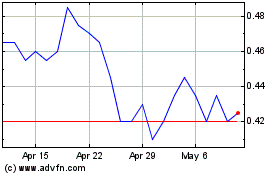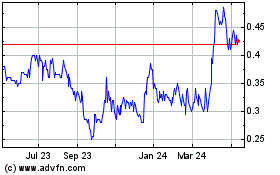VANCOUVER, BRITISH COLUMBIA (FRANKFURT: NBS)(OSLO: NAUR) is
pleased to announce the first NI 43-101 compliant iron resource and
highly encouraging preliminary metallurgical results for its
100%-owned Tapuli magnetite project, 5km from the Stora Sahavaara
magnetite deposit in Norrbotten District, northern Sweden. The
resource has been modeled using a cut off of 15.0% Fe:
- Total Indicated resources are 54.4 million tonnes with an
average grade of 27.7 % Fe.
- Total Inferred resources are 47.6 million tonnes with an
average grade of 26.3 % Fe.
The mineralization remains open below 300m. A NI 43-101
compliant report on the Tapuli resource calculation will be filed
on www.sedar.com within 45 days.
Initial metallurgical test work has produced excellent early
results. The work, performed on a composite drill core sample taken
from seven drill holes from across the resource, indicates that a
high-grade concentrate, up to 69% Total Iron (Fet) and less than
0.03%S, can be produced using a simple flow sheet that comprises
magnetic separation only and does not require a flotation stage.
The concentrate should be suitable as pellet feed, is relatively
coarse grained, and should be transportable by road, rail or ship
year round after filtration.
Buck Morrow, the President of Northland, said:
"Today's news is our third resource calculation on a significant
magnetite body in the last 12 months. Our work has significantly
expanded the historic resource of 60 million tonnes at 29% iron
which was defined by the SGU in the late 1960s. The early results
of the metallurgy are some of the best we've received to date from
our projects and the Tapuli metallurgical flow sheet looks
straightforward. We can now move to the detailed engineering and
planning stage with Tapuli and Stora Sahavaara. An aggressive
winter drilling program is now taking place at Tapuli. In addition
to taking large diameter core samples for further metallurgical
testing, we will continue our drilling at both projects over the
next 12 months with the aim of moving tonnes into the measured
resource category and of expanding both resources. Both magnetite
bodies remain open for expansion."
The Tapuli magnetite deposit occurs as a semi-continuous
mineralized zone beneath an average of 11m of till. The
mineralization has been separated into 7 mineralized lenses, Tapuli
South, Tapuli Central Upper and Lower, Tapuli North Upper and Lower
and Palotieva Upper and Lower respectively. The dip of the
mineralized bodies ranges from 45 to 60 degrees towards the WNW and
NW. Magnetite occurs as relatively continuous lenses which have
been delineated at surface along strike for over 2,000 meters with
true widths within the Central lens of over 200 meters.
GeoVista AB note in their summary that the project has the
potential for commercial exploitation given:
- the scale of the deposit, which could be combined with other
major magnetite deposits also being evaluated by Northland within a
radius of some 40 kilometers, including ... the Stora Sahavaara
magnetite deposit, five kilometers to the south, and the
Hannukainen magnetite deposit in the neighboring Kolari ironstone
district of Finland;
- the potential to realize major cost savings on initial project
capital requirements, if a development decision is made, by
rehabilitating and feeding into existing infrastructure in
neighboring Finland;
- potential low waste to ore mining ratio; and
- recent, substantial increases in the price for iron ore.
Metallurgical Test Work
Northland has completed metallurgical test programs at SGS in
Truro, UK, under the supervision of Corus Consulting, and at the
Geological Survey of Finland Mineral Processing in Outokumpu,
Finland. The test work investigated the liberation characteristics
of the Tapuli iron mineralization using Davis Tube Tests (DDT)
along with additional dry and wet magnetic separation techniques,
and was completed using mineralized drill core samples (900m of
core) from 7 drill holes taken across the Tapuli resource.
The work produced magnetite concentrates with in excess of 69%
total iron (Fet) and less than 0.03%S and demonstrates that a
saleable product can be made from the iron resource using a simple
flow sheet that comprises magnetic separation only and does not
require a sulphide flotation stage. Furthermore, the liberation of
the Tapuli ore appears such that resultant concentrate should be
relatively coarse: the effective liberation size lies somewhere
between 106 and 250 microns. This concentrate should be
transportable by road, rail or ship year round after filtration and
should be saleable as a pellet feed; or even for use as a part-feed
to a sinter plant. From the data gathered to date we anticipate
good recoveries of 85-90% Fet, with magnetite recovery over
90%.
A bulk sample of 25 tonnes of magnetite drill core is currently
being collected for pilot scale tests for flow sheet development
and to produce at least 4 tonnes of concentrate for additional
metallurgical test work.
The table below provides a more detailed analysis of the average
concentrate generated from the test work at 106 micron grind size
and demonstrates that the Tapuli resource can make a high grade,
low acid gangue concentrate suitable as feed for pelletizing
operations (Note all assays except sulphur were completed using
XRF).
Table 1: average concentrate composition for Tapuli magnetite concentrate.
All elements reported as %.
---------------------------------------------------------------------------
Fet S SiO2 Al2O3 MnO CaO MgO P2O5 K2O TiO2 Na2O Cr2O3 Zn Pb V2O5
---------------------------------------------------------------------------
69.1 0.027 0.65 0.2 0.1 0.06 2.0 0.03 less 0.11 0.1 0.02 0.02 less 0.06
than than
0.03 0.01
---------------------------------------------------------------------------
Resource Calculation Methodology
Mineral resources for the Tapuli deposit were prepared and
categorized for reporting purposes by Thomas Lindholm of GeoVista
AB, following the guidelines of the JORC Code.
The Swedish Geological Survey (SGU) began to investigate the
Tapuli and Palotieva deposits in 1965. Core drilling was completed
between 1965 and 1969. Twenty-six holes were drilled on the Tapuli
occurrence, totaling 6,280 meters; of these the majority has
density determinations. Northland's 2007 drilling program added 37
holes for a total of 5,697 meters. All the drill holes were
integrated into the current database, which contained a total of
5,603 iron analyses. A verification exercise was conducted on the
historic data, which included: locating and verifying the location
of drill collars and a review of drill hole surveys and orientation
data. Two historic drill holes were twinned to verify lithological
and assay reliability with good correlation.
Because the Tapuli-area deposits had been explored previously,
Northland was able to move directly to in-fill and deeper hole
drilling and did not undertake any significant mapping or surface
sampling, nor additional detailed geochemical surveys.
Drill core samples were 1 to 2 meter intervals in general,
depending on the mineralization (recent holes generally have 1m
intervals, historical holes typically have 1m or 2m intervals, but
can be considerably longer). All assays were composited to 10m for
use in the interpolation. Different mineralized lenses were defined
using a 15% Fe grade envelope. A total of 7 different mineralized
lenses were delineated and modelled.
The block model was rotated to N55 degrees E to accommodate for
the general strike direction of the deposit. The Block size was
defined as 10 x 20 x 2m (X x Y x Z), at the evaluation each block
was cut against the surface of the modelled wireframe to avoid
volume differences between wireframe model and block model. Block
grades were interpolated in 3 passes using Inverse distance with a
power of 3, with a minimum of 3 and a maximum of 8 samples, with a
maximum of 2 samples from the same hole. For the first pass an
ellipse of 75 x 75 x 10m was used, the second pass used 150 x 150 x
20m and the third and final pass used a 500 x 500 x 40m
ellipse.
Because the mineralized lenses are currently defined by a
50-100m x 100m drilling grid, no measured resources are defined. It
is anticipated that an additional 10 to 15 holes drilled on the
mid-sections within the main Central Tapuli deposit will convert
approximately 50% of the indicated resources to the measured
category.
Indicated mineral resources are defined as those portions of the
deposit generally drilled on a grid of 50-60m x 100m. Inferred
mineral resources are defined as those portions of the deposit
located outside of the indicated resources but inside the
interpreted mineralized zones. Search ellipse 500 x 500 x 40m.
A density function was developed from 1,579 density
determinations carried out on drill core. The density was assigned
to each block according to its grade of Fe as follows below:
Density equals 3.021 + 0.0061 x Fe + 0.00015 x Fe squared +
2.324 x 10 to the power of -6 x Fe cubed
The QA/QC program for Northland's drilling consisted of
inserting blank-samples and duplicate-samples into the sample
train. The ALS Chemex analytical laboratory analyzed the samples in
batches of 81. In each batch, three blanks and three duplicates
samples were inserted to test for cross contamination and
reproducibility of results respectively.
Qualified Person
Thomas Lindholm is the Qualified Person as defined in NI 43-101
responsible for the preparation of all sections in the report
entitled "NI 43-101 Technical Report - Tapuli Resource Estimate"
for Northland Exploration Sweden AB. Mr. Lindholm is employed by
GeoVista AB in Lulea, Sweden and holds an M.Sc. (Mining
Engineering, exploration) from the University of Lulea, Sweden and
is a member of the Australasian Institute of Mining and Metallurgy.
He has worked in minerals exploration and mining for over 25 years
including more than 10 years as a mine development engineer
responsible for resource estimation in open pit and underground
mine projects.
Dibya Kanti Mukhopadadhyay MSc., member of the Australasian
Institute of Mining and Metallurgy, employed by Micon International
Co Limited, also a Qualified Person as defined in NI 43-101, has
verified the grade interpolation protocol for the resource model
calculation.
The metallurgical work was performed under the supervision of
Paul Marsden, VP Metallurgical Development and Operations for
Northland. Mr. Marsden is a member of the IMMM, a Chartered
Engineer and a Chartered Scientist and is the Qualified Person as
defined in NI 43-101 responsible for overseeing the design and
execution of the metallurgical test work program at Tapuli. Mr.
Marsden has verified that the results presented here have been
accurately summarized from the results reported to Northland.
About Northland (www.northlandresourcesinc.com)
Northland is a well-structured, debt free junior exploration
company with a portfolio of high quality iron, gold, and base metal
exploration projects in Sweden and Finland.
ON BEHALF OF THE BOARD
Buck Morrow
NORTHLAND RESOURCES INC.
The TSX Venture Exchange does not accept responsibility for the
adequacy or accuracy of this release.
Contacts: Northland Resources Inc. Buck Morrow President Toll
Free: 1-866-719-8962 Northland Resources Inc. Ralph Rushton
Investor Relations - North America Toll Free: 1-866-719-8962
Website: www.northlandresourcesinc.com
Nevgold (TSXV:NAU)
Historical Stock Chart
From Apr 2024 to May 2024

Nevgold (TSXV:NAU)
Historical Stock Chart
From May 2023 to May 2024
